Revised 13 January 2022
Accepted 25 November 2022
Available Online 10 January 2023
- DOI
- https://doi.org/10.55060/s.atssh.221230.033
- Keywords
- Large-scale Christmas decorations
Light-spatial constructions
Video mapping
Light shows
Open public space
City context
Media technologies
Artistic image of buildings
Contemporary city
Visual attractiveness of the urban environment - Abstract
The penetration of digital technologies into all spheres of life in the 21st century has rapidly increased the speed of information transmission and formed new habits in the perception of various symbols. This process generated a new public demand for a widespread increase in the visual attractiveness of the urban environment. The response to such a request was the development and widespread dissemination of video mapping as an important form of urban art. Another notable trend of recent times is the trend of large-scale constructions of New Year's light-spatial structures, modeling another level of reality of urban architecture, different from the ordinary one. The breadth and mass distribution of such “urban decoration” in completely different parts of the globe, significantly different from the established traditions of festive decoration of cities even 30–40 years ago, forces us to take a closer look at this phenomenon, which in recent years has become a striking feature of urban life in the 21st century.
- Copyright
- © 2022 The Authors. Published by Athena International Publishing B.V.
- Open Access
- This is an open access article distributed under the CC BY-NC 4.0 license (https://creativecommons.org/licenses/by-nc/4.0/).
1. INTRODUCTION: ROLE OF FESTIVE DECORATIONS AND LIGHT SHOWS IN THE STRUCTURE OF URBAN EVENTS IN THE 21ST CENTURY
The development of video mapping as separate large-scale and very visually diverse art form, originally designed to work in large public spaces, offered the world new scenarios of life and entertainment in the city of the new millennium. Moreover, the universality of the technologies used allows us to speak about the absolute internationality of the proposed methods of entertainment, which work equally effectively in cities with a different cultural and artistic background. The conversation about stylistic incompatibility or unsuitable environment has simply lost its relevance, since any three-dimensional environment using video mapping technologies is perceived as something insignificant and secondary, an auxiliary background. Traditional architecture seems to have lost its original aesthetic and emotional impact (Fig. 1).
Fixing the relatively intermediate stage of transition from attentive response to the features of the architectural environment, inherent, for example, to contextualism and the environmental approach of architectural thinking of the 1970s–1980s, to the complete disregard of the architectural and spatial environment in some of the latest flashy digital architecture projects of the 2010s, it is worth noting as a remarkable phenomenon the trend of large-scale constructions of New Year's light-spatial structures, modeling another reality level of urban architecture, different from the ordinary one [1]. This festive glowing frame, which appears against the background of usual buildings of any city, is designed to quickly create a positive festive atmosphere and literally color the urban space with new shapes and colors. The breadth and mass distribution of such “urban decoration” in completely different parts of the globe, significantly different from the established traditions of festive decoration of cities even 30–40 years ago [2], forces us to take a closer look at this phenomenon, which in recent years has turned into a noticeable trend in the life of cities of the 21st century.
The next level of visual modeling of the space “on top” of the already existing architectural and spatial environment, especially spectacular at night, is video mapping, which began to be actively present in the life of cities since the mid-2000s. A decade later, numerous festivals of light and one-time light shows not only became a familiar attraction of urban life in different countries, but also entered the list of recommended tourist features of many cities (comparable to traditions of the Venetian carnival or Mardi Gras processions in New Orleans), which should be considered by tourists when planning their trips to one or another corner of the world.
The study of these processes as a popular form of increasing attractiveness of life in a particular city, typical for the 2000s and especially 2010s (before the pandemic), seems to the author an urgent topic in the context of discussion about the general level of visual entertainment in urban culture in the 21st century.
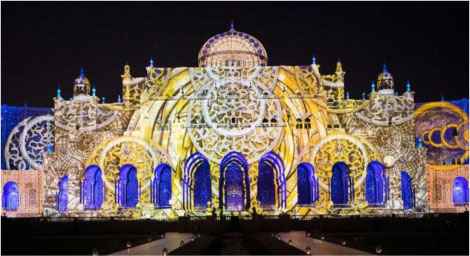
Sharjah Light Festival (Sharjah, UAE, 2020).
2. CHARACTERISTICS OF FESTIVE LED DESIGNS
Spatial models of light festive designs, which appeared in various cities around the world in the 2000s and especially in the 2010s, have a surprisingly similar design [3]. In a certain sense, we can talk about universal “international” models of festive decoration of cities in the new century, regardless of the geography and artistic traditions of the original architecture of these places. Among the proposed solutions, there are several spatial models that are arbitrarily installed in almost any urban environment, regardless of the original stylistic features of the city.
The most common element can be considered expanded versions of garlands, supplemented with more developed decorative details located high above the carriageway of streets and avenues. At the same time, additional decorations can be in the form of plant motifs or winter attributes of the Christmas celebration, as well as thematic and abstract geometric light decorations (Fig. 2).
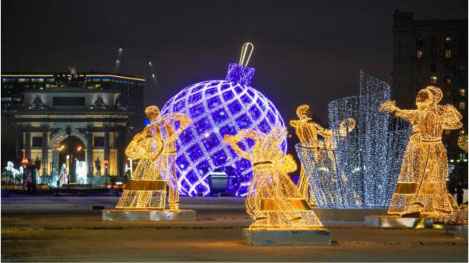
Thematic light sculptures: Christmas Ball (Moscow, Russia, 2019).
Very popular types of urban light-spatial decorations can also be considered LED trees, 3D dimensional light figures, light fountains, street consoles mounted on stationary lampposts or facade elements, garlands on trees and the already mentioned multiple constrictions between houses.
Light-spatial structures (LEDs on metal supports) are advantageous for the urban economy, as they have a long service life and their segments can be mounted in different configurations, updating and repairing as needed. As these are collapsible structures, they are convenient to transport and store, assembling each year in a new place. The low weight and lightness of the fasteners makes the installation of such structures a quick task. Modern colorful coatings and the actual materials of structures are designed for a variety of weather conditions and can withstand the effects of natural factors and the aggressive anthropogenic environment of a large metropolis [4,5].
Despite the widespread practice of festive LED Christmas decorations, Asian countries are the undisputed leader in the quantity and scale of decorations used. Starting from simple grids of LED lamps stretched over individual elements of urban landscaping and building facades, up to entire light parks with imitation of full-scale multi-level vegetation and multi-tiered spatial structures.
3. TRANSFORMATION OF ELEMENTS OF URBAN DECOR IN THE NEW CENTURY
Among all types of urban street decorations appearing on streets and squares of modern cities for various holidays, New Year (Christmas) winter decorations are usually the most ambitious and spectacular. The greatest costs and a high variety of LED spatial decorations appear precisely for the calendar change of numbers in winter. Following the ingrained Western and original Christian tradition, the New Year is celebrated as a special holiday regardless of the actual weather conditions (winter is not everywhere), for example, in Australia or Singapore.
From the point of view of increasing the imagery of urban space in recent years, there are several general trends in decorating cities for holidays and festivals. Among the proposed strategies, figurative and thematic lines themselves stand out, that is, the creation of sculptures and decor on a specific topic, or imitation of trees and other natural environments, as well as a certain trend towards the use of light spatial abstractions. Unfortunately, the authorship of the design of the urban decor used is difficult to establish, because in most cases, the manufacturer is indicated, but not the authors of the art forms. The only exceptions are cases with a clear public resonance. For example, the abstract cubist light installation ABIES-Electronicus (project of the bureau 1024 Architecture) conditionally imitating a traditional spruce tree on the Market Square of Brussels in Belgium (the project of the 19-meter art object was made as part of the annual Festival of Light) [6].
Popular in the last century, additional decorations on lampposts in the new century have turned into three-dimensional hinged spatial forms that significantly change the appearance of both one light pole and the entire street, in which a series of such decorations is located. In the 2010s, not only individual fragments of squares, but entire ceremonial avenues and boulevards regularly acquired an additional festive light appearance, noticeably changing the impression of the traditional appearance of a particular place in a particular city. For example, large-scale New Year decorations turned Chavchavadze Avenue in Tbilisi (Georgia) into a starry sky with an abundance of planets, then into a giant ballroom with luxurious chandeliers. Similar transformations could be found in European cities and on other continents (Fig. 3).
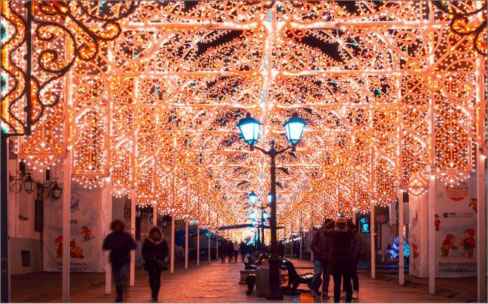
Light tunnels, arcades and galleries in Nikolskaya Street (Moscow, Russia, 2016).
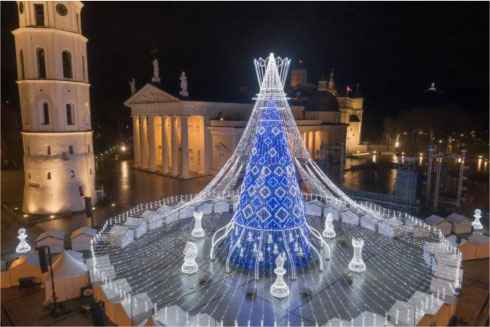
Themed sculptures and light decorations: “Chess” (Vilnius, Lithuania, 2019).
Since the mid-2000s, in Moscow, St. Petersburg, Turin, Valencia or Jerusalem, one could meet festive light-spatial structures that create the effects of light tunnels or shopping galleries with references to the architecture of the 19th century, enhancing the sense of continuity of history in urban space (Fig. 4).
Individual light sculptural groups – animals, angels, bizarre flowers, fragments of architectural forms – which acquired an unprecedented scale and color diversity in the new century, have become immensely popular among citizens and tourists from different countries. In exceptional cases, there were even persistent associations with the interiors of Christian churches inside festive LED structures, which led to the inclusion of such annual decorations in the permanent tourist agenda of specific cities. In places with a large number of already established historical festivals and traditional events, for example, the special veneration of local Christian saints or national memorable dates, the large-scale use of light-spatial decorations was organically included in these celebrations [7]. As a result, the urban space at the time of such events acquired a bright and visually diverse modern sound. At the same time, the choice of the type of artistic compositions of light city decorations in such cases is quite arbitrary, and may both contain certain historical connotations and have a universal and rather abstract geometric character.
A spectacular technique in the overall structure of the lighting design of the festive city was the option of using “running” light: a drop, a snowflake, alternating lighting of multicolored LED lamps along the outline of a decorative shape or part of it. In contrast to the rest, even the multicolored decorative design of static LED festive spatial structures and facades of houses, the “moving” light attracts additional attention and enhances the visual impact on the viewer.
Trees in “clothes” made of a grid of micro bulbs of various colors look equally festive on palm trees and deciduous trees of the Central Russia. Trees decorated in this way on the sides of streets or avenues form the feeling of an almost “Gothic cathedral”, with light directed to the heights. In Asian countries, the location of such light networks of different densities and colors at different heights and with a differentiated configuration is in demand. In fact, special light parks are being created with conditional light grass, trees and shrubs.
4. NATIONAL PECULIARITIES AND STRATEGIES FOR THE USE OF NEW YEAR AND HOLIDAY LIGHT-SPATIAL CITY DECORATIONS
If in the 1980s New Year decorations consisted of small light garlands, additional colored lanterns and other small-scale additions to the light framing of urban space, then in the new century new types of urban festive decorations gradually spread, claiming independent figurative and artistic value and often becoming separate city attractions. In some countries, LED flowers and light trees become a particularly popular motif, and thematic historical or architectural compositions are in particular favor somewhere. As a result, the urban space of the 2010s may abound with variants of intricate light-spatial labyrinths, towers, etc. Figurative and symbolic references can even become the theme of a separate light decoration of an entire urban fragment or district. For example, in Vilnius 2020, chess was the theme of the New Year's light city decorations; and in Tbilisi 2021–2022 contemporary world’s famous buildings and architectural monuments (Fig. 5). That is, by the mid-2010s, a persistent trend began to emerge to form thematic concepts of New Year and festive light-spatial decorations.
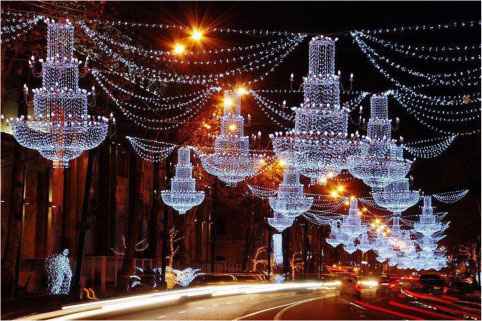
Light figures and sculptures in Chavchavadze Avenue (Tbilisi, Georgia, 2019).
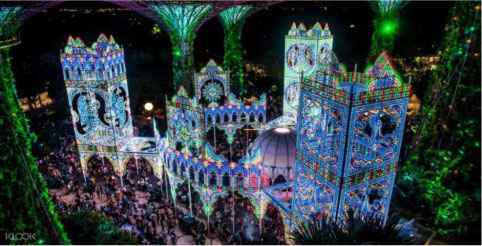
“Wonderful Christmas Gardens” festival in Singapore (2019).
Free-standing decorative elements, assembled as a constructor in a kind of squares in historical quarters, are a good imitation of geometrically correct squares of European cities of the Baroque period and later urban planning decisions of the 19th century. This technique is more often used in large open spaces as the main organizing spatial element of festive LED decorations. Interestingly, this model of spatial organization of festive space is especially common in Asian cities [8]. Examples are Singapore (Fig. 6), Kobe and Jerusalem.
Various floral or New Year's motifs and decorative references to local artistic traditions, symbols or even entire architectural monuments are chosen as possible sculptural motifs. Sometimes the semantics of the selected scenery acquires a certain local binding. For example, in recent years, fragments of order architecture, echoing with the real order decorations of the facades of famous palaces, have been a popular method of lighting New Year decorations in St. Petersburg. And the light grids on palm trees along the streets turned out to be very appropriate in Dubai's New Year decorations, further brightening the city to the expositions of EXPO 2020 postponed due to the pandemic.
5. LIGHT SHOWS IN THE CITIES OF THE NEW MILLENNIUM: DEGREE OF DISTRIBUTION, NATURE OF EVENT, MASS CHARACTER, PROSPECTS
Consideration of static light-spatial decorations and structures with the effect of “moving” light logically leads us to talk about the role of such a dynamic form of visual decoration of urban space as architectural video mapping in the perception of the image of the city of the 21st century. The presence of light festivals and thematic light shows in the calendar of urban events became a noticeable phenomenon by the mid-2000s, and in the following decade it turned into a number of familiar forms of urban figurative and artistic activity [9,10].
The proposed transformations of light projections of the most unexpected images on familiar buildings look equally spectacular in Dubai, Berlin (Fig. 7), Moscow and Singapore. Many cities switched to the regular format of holding such events and festivals after the first successful experience. Before the outbreak of the pandemic, such city holidays immediately moved into the category of the most massive public spectacles, along with football matches and concerts by popular musicians. The use of iconic local buildings as the initial background for the subsequent transformation of the image fixed the local binding of each event, making the festival recognizable for a particular city. And the multiplicity and variety of images increased the attractiveness of such a city event for residents and tourists [11]. With the transition to the regular format of festivals, annual differences began to be designated by consistently choosing a common new theme, and sometimes by changing the methods of artistic presentation of visual images. For example, one of the video mapping festivals in Berlin focused on the method of transferring visual images to the surface of the Cathedral with color spots in the pointillist style, in another year, collections of projections abounded with imitations of structural drawings and showed the cathedral itself and other projected images “in the section”. And for the Sharjah Light Festival in UAE, projections of patterns of national architectural elements were developed: mashrabi sunscreens (Fig. 8). Perhaps the current realities of public and political life will make their own adjustments to the nature and frequency of various city festivals around the world. But when analyzing the visual fullness of urban public life in the first two decades of the new century, we can safely designate video mapping as one of the most vivid and expressive, albeit short-term, artistic means of reflecting the capabilities of modern computer technologies in the daily life of citizens.
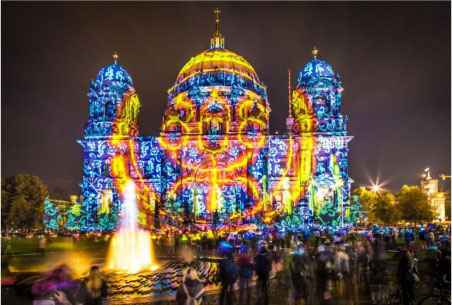
Architectural video mapping: Light Festival in Berlin, Germany (2017).
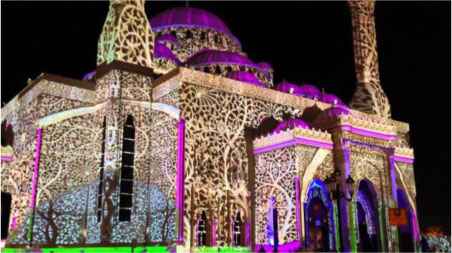
Light ornament with imitation of the traditional mashrabiya pattern (Sharjah Light Festival, UAE, 2020).
6. CONCLUSION
Summing up the conversation about ways to increase the visual attractiveness of urban spaces in the 21st century, we note that among the various strategies of public art and other mechanisms for coloring the urban fabric, various forms of using video mapping and festive light decorations are particularly effective.
The massive spread of digital technologies and the appearance of a large number of LED screens in the urban space made it possible to model the entertainment of the architectural environment of a modern city in a new way. At the same time, regular festivals of mainly architectural video mapping and large-scale festive light-spatial decorations are not only a popular tourist strategy, but also the most vivid, colorful and noticeable element of aesthetically meaningful improvement of modern cities.
In almost all countries, festivals of video mapping and light-spatial decorations have an administrative and artistic character. They do not carry a pronounced social agenda and this is their difference from socially-oriented strategies of public art, participatory art actions and other practices of modern street art [12]. The festive festivals and light shows held are even more engaged by the authorities than the large-scale muralism of the mid-2000s–2010s.
The appearance of large-scale festive decorations in both historical and new mass, including high-rise, residential buildings, is widespread and in most cases has an international character.
From an artistic point of view, such contrasting light and color interference in the urban environment looks very aggressive. Therefore, its a priori temporary nature should be perceived as a benefit and a way to more carefully assess the established urban environment outside the festive format, noting its advantages and disadvantages and forming guidelines for fundamental improvement.
References
Cite This Article

TY - CONF AU - Marianna Maevskaya PY - 2023 DA - 2023/01/10 TI - Large-Scale Christmas Decorations and Light Shows as a Universal Way to Increase the Visual Attractiveness of the Urban Environment in the 21st Century BT - Proceedings of the 4th International Conference on Architecture: Heritage, Traditions and Innovations (AHTI 2022) PB - Athena Publishing SP - 247 EP - 252 SN - 2949-8937 UR - https://doi.org/10.55060/s.atssh.221230.033 DO - https://doi.org/10.55060/s.atssh.221230.033 ID - Maevskaya2023 ER -









